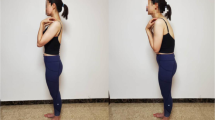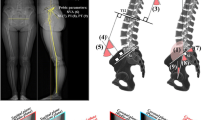Abstract
Purpose
The line of sight when whole-spine radiographs are taken has not been defined. In our 2012 health screening study (TOEI study), whole-spine radiographs were taken with the volunteers in the most relaxed position and with a horizontal gaze. However, in the TOEI 2014 study, a mirror was placed in front of their faces to unify their line of sight. To our knowledge, there are no reports on how the sagittal alignment changes when radiographs are taken using a mirror. The purpose of this study was to investigate how mirror placement impacted sagittal spinal alignment in whole-spine radiographs taken while standing.
Methods
Volunteers who participated in both the TOEI 2012 and 2014 studies were recruited. Pelvic tilt (PT), lumbar lordosis (LL), thoracic kyphosis (TK), cervical lordosis (CL), slope of McGregor’s line (McGS), and C7 sagittal vertical axis (C7 SVA) were examined using software.
Results
Three hundred fifty-four volunteers (142 males, 212 females, average age in 2012: 72 years) whose radiographs were evaluated in both previous studies were enrolled. The average parameters of 2012 and 2014 were: PT: 18° and 21° (P < 0.01), LL: 40° and 40°, TK: 34° and 34°, CL: 13° and 23° (P < 0.01), McGS: 2° ± 11° and − 9° ± 8° (P < 0.01), and C7 SVA: 46 and 23 mm (P < 0.01), respectively. In the Levene test, the McGS variation in 2014 [95% confidence interval (CI) 0.9–3.4] was significantly smaller than that in 2012 (95% CI − 9.7 to − 8.0, P < 0.01).
Conclusion
The smaller McGS variation in the TOEI 2014 study suggested that mirror placement could standardize the head’s position. These results showed that the mirror placement retroflexed cervical alignment and caused the head to lean backward. It is important that a mirror is placed to unify the line of sight.




Similar content being viewed by others

References
Vedantam R, Lenke LG, Bridwell KH et al (2000) The effect of variation in arm position on sagittal spinal alignment. Spine (Phila Pa 1976) 25:2204–2209
Park SM, Song KS, Park SH et al (2015) Does whole-spine lateral radiograph with clavicle positioning reflect the correct cervical sagittal alignment? Eur Spine J 24:57–62
Aota Y, Saito T, Uesugi M et al (2009) Does the fists-on-clavicles position represent a functional standing position? Spine (Phila Pa 1976) 34:808–812
Marks MC, Stanford CF, Mahar AT et al (2003) Standing lateral radiographic positioning does not represent customary standing balance. Spine (Phila Pa 1976) 28:1176–1182
Horton WC, Brown CW, Bridwell KH et al (2005) Is there an optimal patient stance for obtaining a lateral 36” radiograph? A critical comparison of three techniques. Spine (Phila Pa 1976) 30:427–433
Faro FD, Marks MC, Pawelek J et al (2004) Evaluation of a functional position for lateral radiograph acquisition in adolescent idiopathic scoliosis. Spine (Phila Pa 1976) 29:2284–2289
Laouissat F, Sebaaly A, Gehrchen M et al (2017) Classification of normal sagittal spine alignment: refounding the Roussouly classification. Eur Spine J. doi:10.1007/s00586-017-5111-x (Epub ahead of print)
Oe S, Togawa D, Nakai K et al (2015) The influence of age and sex on cervical spinal alignment among volunteers aged over 50. Spine (Phila Pa 1976) 40:1487–1494
Banno T, Togawa D, Arima H et al (2016) The cohort study for the determination of reference values for spinopelvic parameters (T1 pelvic angle and global tilt) in elderly volunteers. Eur Spine J 25:3687–3693
Yoshida G, Yasuda T, Togawa D et al (2014) Craniopelvic alignment in elderly asymptomatic individuals: analysis of 671 cranial centers of gravity. Spine (Phila Pa 1976) 39:1121–1127
Lafage R, Challier V, Liabaud B et al (2016) Natural head posture in the setting of sagittal spinal deformity: validation of chin-brow vertical angle, slope of line of sight, and McGregor’s slope with health-related quality of life. Neurosurgery 79:108–115
Diebo BG, Challier V, Henry JK et al (2016) Predicting cervical alignment required to maintain horizontal gaze based on global spinal alignment. Spine (Phila Pa 1976) 41:1795–1800
Genant HK, Wu CY, van Kuijk C et al (1993) Vertebral fracture assessment using a semiquantitative technique. J Bone Miner Res 8:1137–1148
Lee PY, Lin SI, Liao YT et al (2016) Postural responses to a suddenly released pulling force in older adults with chronic low back pain: an experimental study. PLoS One. 11(9):e0162187 (Epub 2016 Sep 13)
Vital JM, Senegas J (1986) Anatomical bases of the study of the constraints to which the cervical spine is subject in the sagittal plane. A study of the center of gravity of the head. Surg Radiol Anat 8:169–173
Dvorak J, Froehlich D, Penning L et al (1988) Functional radiographic diagnosis of the cervical spine: flexion/extension. Spine (Phila Pa 1976) 13:748–755
Yu M, Zhao WK, Li M et al (2015) Analysis of cervical and global spine alignment under Roussouly sagittal classification in Chinese cervical spondylotic patients and asymptomatic subjects. Eur Spine J 24:1265–1273
Author information
Authors and Affiliations
Corresponding author
Ethics declarations
Conflicts of interest
Shin Oe and Daisuke Togawa belong to a funded laboratory called the Division of Geriatric Musculoskeletal Health.
Sources of funding
The sources of funding are: Medtronic Sofamor Danek Inc. Japan Medical Dynamic Marketing Inc. Meitoku Medical Institution, Jyuzen Memorial Hospital.
Ethical approval
The study’s protocol was approved by the institutional review board of Hamamatsu University School of Medicine, Shizuoka, Japan.
Rights and permissions
About this article
Cite this article
Oe, S., Togawa, D., Yoshida, G. et al. Effects of mirror placement on sagittal alignment of the spine during acquisition of full-spine standing X-Rays. Eur Spine J 27, 442–447 (2018). https://doi.org/10.1007/s00586-017-5351-9
Received:
Revised:
Accepted:
Published:
Issue Date:
DOI: https://doi.org/10.1007/s00586-017-5351-9



